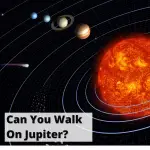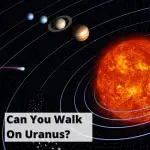No, you cannot walk on the surface of Saturn.
In the article that follows, we’ll explain.
Can You Walk On Saturn? (EXPLAINED)
Introduction To Saturn
Saturn is one of the most recognizable and well known plants in the solar system after Earth.
Almost everyone, even elementary/primary aged children, can identify it, usually because of its size and distinctive rings.
While Saturn has probably been visible as a bright looking star in the sky since humans had the ability to look up and notice such things, the planet itself (and its rings) weren’t formally recognized until the 1600s.
The Pioneer 11 spacecraft got close enough to the planet in the 1970s to provide us with our first close up images of the planet, confirming (and disproving) many of the long-held theories and conclusions about it.
The Surface Of Saturn Isn’t Solid
The primary reason that humans could never walk on Saturn is that the surface of Saturn is not solid.
Like Jupiter, Saturn is known as a “gas giant.”
It is huge, more than nine times the size of Earth.
It is the second largest planet in our solar system, with Jupiter being the only planet in our solar system that is larger.
It is composed of gas, almost all hydrogen and helium.
There are small amounts of ammonia, ethane, methane, and some other gases as well.
If you approached the outer edges of the planet and tried to “land,” your craft would just sink into the mass of gas that makes up most of the planet.
(There isn’t anything solid to land on when you visit Uranus or Neptune either).
We don’t know this for sure, but we suspect (again, like Jupiter) that the interior core of Saturn is solid.
It is highly likely that the rising temperature and pressure as you approach the center of the planet causes the gaseous hydrogen to change to it’s solid phase.
But even if the core of Saturn were solid, humans still couldn’t walk on it.
If the pressure and temperature were high enough to cause hydrogen to harden into it’s metal form, then the pressure would be too high for a human to survive it.
A spacecraft (at least with our current technology) could not reach that area of the planet without being completely destroyed.
And if somehow, a spacecraft could pass through the turbulent outer layers of the gaseous planet to the solid center that we suspect exists, and the human could actually exit the craft somehow to reach the solid surface without dying, the gravity would be too much for a human to actually take a step.
Other conditions that exist on Saturn would make it difficult to walk on Saturn if there was a solid surface humans could reach, such as insanely fast winds.
At times, winds in certain areas can exceed more than 1,000 miles per hour.
Any attempt to approach the planet in times of high winds would probably quickly result in ship destruction and death of all crew members.
Don’t forget extreme hot and cold temperatures, as well as the lack of a breathable atmosphere either.
Needless to say, taking a walk on Saturn isn’t going to happen.
Did You Know? (Other Saturn Facts)
Here are some facts you may not have known about Saturn:
- Saturn is located more than 900 million miles from the sun.
- Saturn is the 6th planet from the sun, and it is the planet furthest from the sun that we can observe with the naked eye. Without a telescope or other magnifying device, humans cannot see any of the planets beyond Saturn.
- Saturn has more than 80 moons with some cool names, many of which will be familiar to those who have studied Greek mythology. Familiar names include Altas, Bestla, Calypso, Dione, Helene, Fenrir, Hyperion, Jarnsaxa, Pandora, Prometheus, and Skoll. Not all of Saturn’s moons have names just yet (aside from identifying letters/numbers). To date, Saturn has the most moons of any planet in our solar system, though this could change as we explore.
- Saturn’s rings look thin and small in my depictions/images. While they are thin (only around 20 kilometers thick), they are actually quite wide. The distance across the rings is actually pretty close to the distance between the Earth and Earth’s moon.
- Saturn is thought to be more than 4 billion years old.
- It takes about 10 Earth hours for Saturn to fully spin around one time.
- Saturn is not a perfect round planet. It rotates really fast. It is a gas planet (mostly), which means that its mass is not very dense. With these two characteristics, the planet actually bulges around its equator, sort of like a round ball would look if you squeezed it a bit on opposite ends.
- Saturn’s gaseous makeup means that it is not dense. As such, if there were a body of water larger than Saturn that we could put Saturn into, Saturn would probably float.
- One trip around the sun takes Saturn the equivalent of about 30 Earth years. Compare this to Jupiter, which takes only 10 years to orbit the sun one time.
- Some of the clouds surrounding Saturn are composed of ammonia ice.
- Saturn is not a habitable planet, in any way shape or form, for life that we know of. We aren’t exploring it like we are Mars for its potential. Some of Saturn’s moons, however, could possibly be habitable.
- Saturn is the name of a god in Roman religion in ancient times. Saturn was a god of many important aspects of Roman life, including agriculture, time, wealth, and plenty.
- In Roman mythology, the god Saturn fathered Pluto, Jupiter, and Neptune, among others.
Wrap Up
Saturn is a fascinating planet, and we look forward to learning more about it as the progress of space exploration continues.
You might also enjoy:







